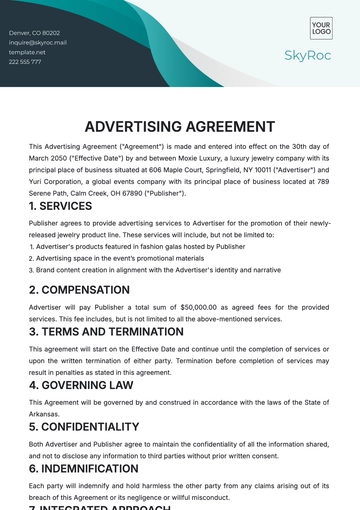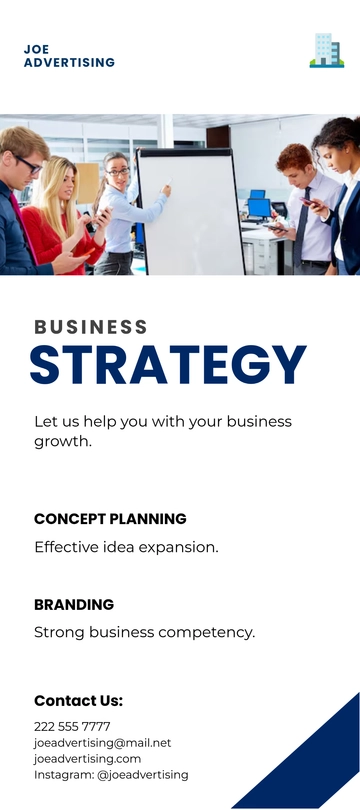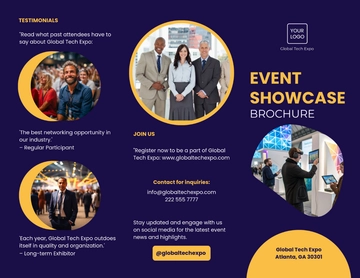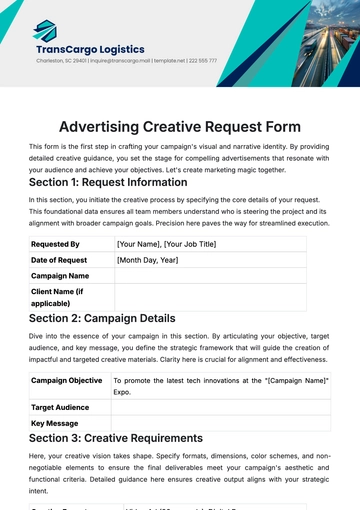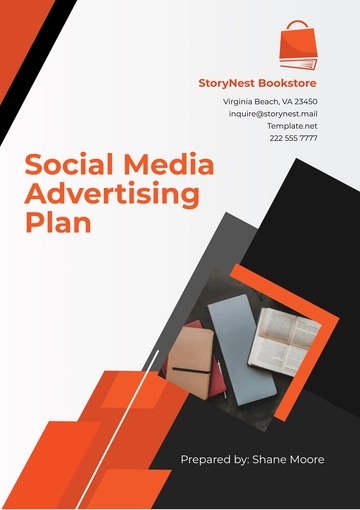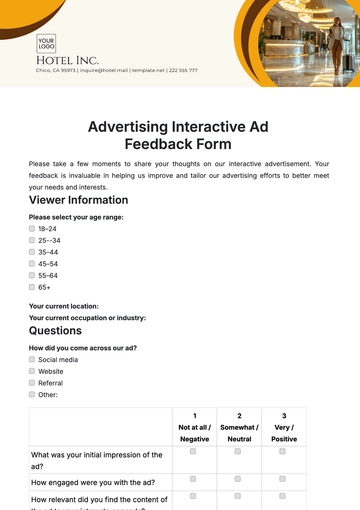Free Advertising Campaign Media Strategy Document

I. Introduction
The media landscape is rapidly evolving, necessitating a dynamic and adaptive approach to campaign strategy. [Your Company Name] is committed to developing a media strategy that not only resonates with the audience but also sets the benchmark for innovation and effectiveness. This document serves as a guide to our tailored media approach.
Market Trends and Insights
Understanding current market trends is crucial for developing an effective media strategy. We analyze various factors, such as shifts in consumer behavior, emerging media platforms, and competitive landscape dynamics. This analysis will guarantee that our strategy is ahead of the curve in adapting to market changes.
Strategic Approach and Philosophy
Our strategic approach is rooted in a deep understanding of our clients' unique goals and the specific needs of their target audience. We believe in a balanced blend of creativity and data analytics to drive campaign success. Our philosophy centers around creating compelling narratives that are delivered through the most impactful channels, ensuring maximum engagement and conversion.
II. Media Strategy Overview
This section provides an overview of our media strategy, designed to effectively communicate the campaign's message and achieve its objectives. We have developed a multi-faceted approach that encompasses a broad range of media channels, each tailored to specific audience segments and campaign goals.
A. Objectives
Our strategy aims to elevate the campaign's visibility by harnessing high-impact channels and creative messaging that resonates with the target audience.
We focus on creating content that not only reaches but also deeply connects with different demographic segments, fostering a strong brand relationship.
By strategically aligning our media channels and content, we aim to encourage measurable actions, from website visits and sign-ups to direct purchases, thereby driving conversion rates upward.
B. Audience Segmentation and Analysis
Understanding the audience is pivotal in crafting an effective strategy. We have conducted an extensive analysis of audience demographics, psychographics, and media consumption habits to ensure that our messaging is precisely targeted and relevant.
C. Channel Optimization and Integration
Our approach involves a varied selection and integration of different media channels, ensuring each plays a specific role in the overall strategy:
Digital Platforms: Implementing advanced search engine optimization techniques to enhance online visibility and rank higher in search engine results, thereby attracting a relevant audience actively seeking related content or services.
Social Media: Crafting unique content strategies for each social media platform, recognizing the varied user demographics and content preferences on platforms like Facebook, Instagram, Twitter, and LinkedIn.
Traditional Media: Creating compelling advertisements and sponsorships that align with prime viewing/listening times, targeted to reach a broad audience with high-impact messaging.
Emerging Media: Partnering with popular podcasts for sponsorships or creating branded podcast series, tapping into a highly engaged listener base. Additionally we had worked with influencers whose followers align with the target audience, leveraging their credibility and reach to promote the campaign.
Innovation and Adaptability
In a rapidly changing media landscape, our strategy is not static. We continuously monitor campaign performance, audience engagement, and market trends to adapt and innovate our approach. This flexibility ensures that the campaign remains effective and relevant throughout its lifecycle.
III. Target Audience Profile
Our campaign strategy is built upon a deep understanding of our target audience. We have identified key demographic groups and have developed comprehensive profiles for each, considering their unique characteristics, preferences, and media consumption patterns.
Group A: Young Adults (18-25 Years)
Characteristics: Tech-savvy, environmentally conscious, value authenticity and social responsibility.
Interests: Latest technology trends, sustainable living, social media influencers, and entertainment.
Preferred Media Channels: Social media (Instagram, Snapchat, TikTok), streaming services, YouTube, podcasts.
Behavioral Insights: Highly engaged with mobile devices, responsive to influencer marketing, and advocates for brands with a purpose.
Group B: Professionals (26-40 Years)
Characteristics: Career-oriented, financially conscious, family-focused, seeks convenience and efficiency.
Interests: Financial planning, health and wellness, family entertainment, career development.
Preferred Media Channels: LinkedIn, financial and lifestyle blogs, news websites, streaming podcasts, email newsletters.
Behavioral Insights: Values content that provides utility and enrichment, likely to engage with educational and informative material.
Group C: Mature Adults (41-55 Years)
Characteristics: Value stability, health-conscious, community-oriented, prefer quality over quantity.
Interests: Healthcare, retirement planning, travel, community events, home improvement.
Preferred Media Channels: Traditional media (television, radio, newspapers), Facebook, community forums, travel websites.
Behavioral Insights: Seeks trusted sources of information, responsive to detailed and clear messaging, appreciates personalization.
Customized Content Strategy for Each Segment
For each of these demographic segments, [Your Company Name] develops a customized content strategy that aligns with their preferences and habits. This will make sure that our messaging is not only reaching the right audience but also engaging them effectively and driving them towards the desired action.
IV. Media Channels and Tactics
In this section, we provide an in-depth look at the various media channels and tactics employed in our strategy, along with data showcasing the specifics of our approach. This includes channel selection, strategic intent, and frequency of deployment
Channel | Strategy | Frequency |
Social Media | Interactive and shareable content creation | Daily |
Television | Prime time ads and show sponsorships | Weekly |
Digital | SEO, targeted ads, email marketing | Ongoing |
Print Media | Full-page ads, newspaper inserts | Monthly |
Radio | Drive-time ads, show sponsorships | 5 Spots per Week |
Podcasts | Sponsored mentions, branded series | Bi-weekly |
Emerging Media | AR/VR experiences, new platform collaborations | As Available |
Key Notes on Strategy Implementation
Social Media: Creating daily interactive posts such as polls, live sessions, and user-generated content challenges. Implementing a robust content calendar that includes viral trends, timely topics, and consistent brand messaging.
Television and Radio: Placing high-impact ads during prime viewing and listening times. Engaging in show sponsorships and branded segments tailored to our audience's interests.
Digital: Maintaining a strong SEO presence to enhance organic reach. Deploying targeted digital advertising campaigns across search engines and social platforms. Regularly distributing engaging email newsletters with exclusive content and offers.
Print Media: Placing ads and editorial content in widely-read magazines and newspapers. Using direct mail for targeted, personal outreach. The goal here is to establish credibility and trust with a tactile experience.
Podcasts: Partnering with popular podcasts for sponsorships and creating branded podcast series. Tailoring content to align with the interests of specific listener demographics.
Emerging Media: Investing in AR/VR experiences to offer immersive brand interactions. Experimenting with new platforms and technologies to connect with early adopters and tech-savvy audiences.
V. Budget Allocation
Our budget allocation is designed to ensure optimal utilization of resources across various media channels. This will make a balanced investment in line with the expected reach and impact of each channel. Below is a detailed table outlining the budget allocation for each media channel.
Channel | Amount | Justification |
Social Media | $175,000 | High engagement, direct reach to target audience |
Television | $125,000 | Broad reach, high-impact visibility |
Digital | $100,000 | Continuous online presence, targeted advertising |
Print Media | $50,000 | Credibility, tangible brand presence |
Radio | $25,000 | Access to local markets, drive-time effectiveness |
Podcasts | $15,000 | Niche audience targeting, growing popularity |
Emerging Media | $10,000 | Innovative engagement, future market potential |
The pie chart shows the percentage of budget.
Social Media: Exceptional engagement rates and precision targeting capabilities. Social media platforms provide robust analytics and audience insights, allowing for highly customized content that resonates with specific demographics. Ideal for real-time engagement and brand-building.
Television: Offers wide-reaching impact and brand reinforcement. Television's visual and auditory appeal delivers high-impact messaging, ideal for storytelling and creating memorable brand experiences. Effective for reaching a diverse, broad audience.
Digital Platforms: Essential for maintaining a strong and consistent online presence. Leveraging SEO, PPC, and digital advertising allows for direct and measurable engagement with the target audience. Versatile in addressing various stages of the consumer journey, from awareness to conversion.
Print Media: Effective in reaching specific demographics, particularly those who value traditional media formats. Print media lends a sense of credibility and permanence to the campaign, providing a tangible brand presence.
Radio: Ideal for local market penetration and achieving high ROI, especially during peak listening times. Radio's wide reach and auditory engagement are effective for reinforcing brand messages and reaching audiences during daily commutes.
Podcasts: Podcasts offer a unique opportunity to engage with niche audiences in a personal and immersive format. This medium is growing rapidly, providing an avenue for targeted storytelling and deep audience connection.
Emerging Media: Allocating funds to innovative channels like AR/VR and emerging digital platforms demonstrates a commitment to staying at the forefront of technological advancements. This investment not only captures the attention of early adopters and tech enthusiasts but also positions the brand as an innovative leader.
VI. Performance Metrics
To ensure the success and effectiveness of our media strategy, [Your Company Name] employs a comprehensive set of performance metrics. These metrics are tailored to each channel and objective, allowing us to track progress, evaluate impact, and make data-driven adjustments.
Channel | Key Metrics | Target Goals |
Social Media | Engagement Rate, Follower Growth | 10% increase in engagement rate |
Television | Viewer Impressions, Ad Recall | 20% increase in viewer impressions |
Digital | Website Traffic, Click-Through Rate | 30% increase in website traffic |
Print Media | Readership Reach, Response Rate | 15% increase in readership reach |
Radio | Listener Reach, Engagement Metrics | 25% increase in listener reach |
Podcasts | Listener Numbers, Engagement Rate | 20% increase in listener numbers |
Emerging Media | User Engagement, Innovation Impact | High user engagement |
These performance metrics are crucial for continuously refining our media strategy, ensuring that each channel contributes effectively to the campaign's overall success.
VII. Conclusion
[Your Company Name]'s media strategy is built on a foundation of data-driven decision-making and creative innovation. By focusing on tailored content delivery, strategic channel selection, and continuous performance monitoring, we aim to achieve the campaign's objectives and deliver substantial ROI.
- 100% Customizable, free editor
- Access 1 Million+ Templates, photo’s & graphics
- Download or share as a template
- Click and replace photos, graphics, text, backgrounds
- Resize, crop, AI write & more
- Access advanced editor
Develop top-notch advertising campaigns with Template.net's Advertising Campaign Media Strategy Document Template. Fully customizable and editable in our Ai Editor Tool, it provides an effective structure for strategic planning. It's designed for maximum utility for Marketing Professionals. Enhance your media strategy with this tool, designed to bring your campaigns to life. Standout with well-crafted, engaging and successful ad campaigns.

